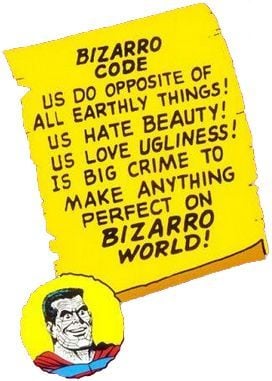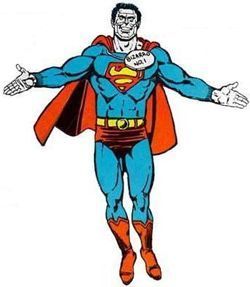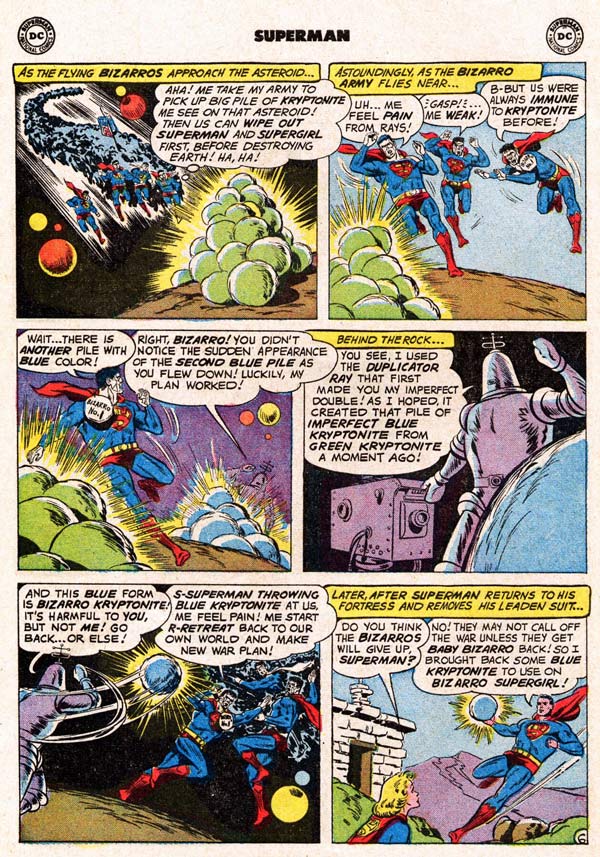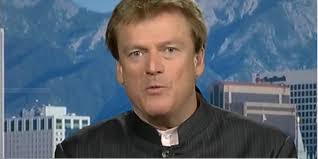
Within minutes of my introduction to the world of short selling hedge funds, I encountered the analogy that remains the best suited to describe the truth to which they subscribe: Bizarro World.
A planet that appears from time to time in the DC Comics universe, Bizarro World is noteworthy for its utter opposition to everything associated with reality on Earth (in fact, another name for Bizarro World is Htrae – “Earth” spelled backwards).
Bizarro World made very infrequent appearances in the DC Comics universe; however what few insights we’ve been able to gain have been telling.
For one, we know that the residents of Bizarro World adhere to a simple moral code: “Us do opposite of all Earthly things! Us hate beauty! Us love ugliness! Is big crime to make anything perfect on Bizarro World!”

For another, consistent with its black-is-white nature, the alpha-superhero of Bizarro World – a Superman-like figure appropriately named ‘Bizarro’ – is in fact a super villain, and one of many.
Fortunately, or possibly unfortunately, the Bizarro World of short selling hedge funds sits side-by-side with our own. Yet, true insights into how it actually operates have been startlingly rare.
Possibly the best behind-the-curtains view came in December of 2006, with Jim Cramer’s infamous admission as to how short selling hedge funds do (and indeed, according to Cramer, “must”) operate, moving the Bizarro World citizenship of that group from theory to undeniable fact.
See for yourself:
Cramer: “You can’t foment. You can’t create yourself an impression that a stock’s down. But you do it anyway because the SEC doesn’t understand it. So that’s the only sense that I would say that it’s illegal.”
Bizarro translation: “Us do opposite of all Earthly things! Us can break law to make money because regulator not understand regulations!”
Cramer: “Look what people can do. I mean that’s a fabulous thing! The great thing about the [stock] market is that is has nothing to do with the actual stocks. Look, over maybe two weeks from now the buyers will come to their senses and realize everything they heard was a lie…”
Bizarro translation: “Us hate beauty! Us pervert capital markets to make them hostile to small, promising businesses and technologies! Us stock market has nothing to do with actual stocks!”
Cramer: “These are all what’s really going on under the market that you don’t see. What’s important when you’re in that hedge fund mode is to not do anything remotely truthful – because the truth is so against your view, that it’s important to create a new truth to develop a fiction.”
Bizarro translation: “Us love ugliness! Us hate truth! Us prefer fiction!”
Cramer: “I think that it’s important for people to recognize the way that the market really works is to have that nexus of ‘hit the brokerage houses with a series of orders that can push it down’, then leak it to the press, and then get it on CNBC (that’s also very important), and then you have kind of a vicious cycle down. It’s a pretty good game.”
Bizarro translation: “Is big crime to make anything perfect on Bizarro World! Us make money by wrecking public companies! And here on Bizarro World, Jim Cramer not even pretend to be friend of small investor! Oh yeah…CNBC official network of Bizarro World!”
(Lest any suppose these clips have been taken out of context, I strongly encourage everybody to download and view the 10 minute conversation in its entirety.)
On Bizarro World, villains are treated like celebrities while the law-abiding are scorned and ostracized. So it should come as no surprise that on CNBC (the official network of Bizarro World), short selling hedge fund managers are called “titans” while those who question them are dismissed with a wink and a smirk.
Of course, this would seem consistent with the seemingly inverted reality that is short selling, where – as opposed to traditional investors who earn profits when they buy low and later sell high – shorts aspire to do the same by first selling high and then buying low.
While on the surface short selling might appear to have been invented on Bizarro World, that’s not true. Shorting is (as has been stated time and again on this blog) a healthy part of a normal market.
What was invented on Bizarro World, however, is shorting’s insidious doppelganger: naked short selling, which is a practice ripped straight from the Bizarro World welcome guide. Unlike legitimate short selling, which requires first borrowing the shares one sells short, naked shorting skips that step, allowing criminals to sell not only something they do not own, but something that does not even exist, except as a tradable electronic ledger entry which they themselves conspire with corrupt brokerages to create.
This, in turn has the effect of artificially increasing the supply of a company’s shares. In other words, on Earth, only companies get to issue stock, whereas on Bizarro World, it’s the naked short sellers that issue shares of a company’s stock, with impunity, sometimes in quantities rivaling the number of legitimate, company-issued shares in circulation (with the expected impact on share price).
Or, should I say, naked short sellers used to be able to do this.
The truth is, since shortly after the onset of the economic crisis naked short sellers themselves helped to spark, naked shorting has become an increasingly difficult crime to commit.
The result?
Despite the fact that we’re in the midst of an epic bear market – when one would normally expect short sellers to thrive – the biggest short selling hedge funds are getting hammered.
Today, Reuters business writer Svea Herbst-Bayliss has a shocking overview of the breadth of the situation, which she begins by comparing to Waterloo – the battle which forever put an end to Napoleon’s aspirations of world domination.
Based on insiders’ insights into forthcoming letters to investors explaining their performance over the first and second quarters of 2009, Herbst-Bayliss predicts that “To anyone considering hedge fund investments in the coming months, the data will illustrate that these managers who cashed in on last year’s financial markets crash now rank as the $1.4 trillion hedge fund industry’s worst performers.”
Specifically, Herbst-Bayliss notes, “In the first six months of 2009 [short selling hedge funds] lost 9.38 percent, compared with the 9.55 percent that other hedge funds gained.”
Most notably, the story quotes Brad Alford, a professional hedge fund advisor and investor, who says, “Every few years short-sellers have their day in the sun. Then things revert to normal where the markets rise and life becomes so difficult for them that many just go out of business,” he added.
In case you missed it, you might want to re-read Alford’s quote to make sure you catch what makes it so telling: that a rising market can be bad for short sellers.
But how can that be, given the recently-ended bull market – possibly the greatest in economic history – saw short selling hedge funds such as SAC Capital, Kynikos Associates and Third Point Capital experience mind-boggling growth, while a month-long rise in what is otherwise shaping up to be one of the greatest bear markets in economic history (when the shorts should be thriving) may prove to be their ultimate doom?
Talk about Bizarro World investing!
The difference, I suspect, is naked short selling: a crutch-like tool that allowed the shorts to defy gravity while the market soared, the effective removal of which has left them atrophied and uncoordinated when forced to fend for themselves in a market where capable, legitimate short sellers should thrive.

Or maybe a more apt metaphor is that of Kryptonite, the green version of which makes Superman weak and Bizarro strong, while the blue version has the opposite effect. For a long time, a captured media and SEC equipped short selling hedge funds with a big, fat slab of green Kryptonite, which their own hubris has caused to be replaced by a bit of the Bizarro-toxic blue stuff.
Will July of 2009 be the short sellers’ Waterloo?
Will short selling hedge funds’ greed simply assume another form?
Will the economy recover before it’s too late to matter?
Find out what happens in the next episode of Deep Capture!








Meantime, the SEC’s fixation with minor miscreants runs unabated.
The organization has prowess aplenty for chasing the smaller ponzi’s, e.g., the occasional creep from NJ, but what about Goldman and the hedgefunds like those of Loeb and Chanos?
Straining at gnats while swallowing camels?
And, where the h-e-doublehockeysticks is that uptick rule?
Judd:
Great piece. Thanks for bringing the true Jim Cramer to light once again for those who may not have seen the video of Jim admitting to criminal market manipulation in his own words.
Another very telling Bizarro statement by Cramer from that video was the following:
“If I wanted it to go lower, I would hit and offer, hit and offer, hit and offer. I could get a stock like RIMM for maybe – that might cost me $15-$20 million annually to knock RIMM down. But it would be fabulous because it would beleaguer all the moron longs who were also keying on Research in Motion.
We’re seeing that. Again, when your company’s in a survival mode it’s really important to defeat Research in Motion. You get the Pisanis of the world and the people talking about it as if there’s something wrong with RIMM. Then you would call the Journal and you get the bozo reporter on Research in Motion, and you would feed that Palm’s got a killer it’s gonna give away.
These are all the things you must do on a day like today. And if you’re not doing it, maybe you shouldn’t be in the game.”
In Bizarro, loosely translated:
“RIMM good! Us hate good! Mom and Pop investors, retirement funds good! Us hate them. They morons. Us hammer RIMM. Make RIMM go down. Steal their life savings. Us love to steal!”
akcje:
We’re patiently awaiting your defense of Cramer. Are you going to try to spin this as Mark Mitchell fiction also? Are we just misreading upstanding, ethical Cramer’s words? … just more dots that help paint the overall picture!
More fodder for the masses..
Financial Times coverage of PeeQwat
Pequot referred to SEC 45 times in four years
By Brooke Masters in New York
Published: August 11 2009 00:50 | Last updated: August 11 2009 00:50
Stock exchange monitors referred Pequot Capital Management to the Securities and Exchange Commission for possible securities violations, including insider trading, at least 45 times between 2005 and this year, the commission has revealed in a letter to the US Congress.
The SEC is probing allegations that Arthur Samberg, the hedge fund’s chairman, received privileged information from a Microsoft employee in 2001 and used it to generate profits of $14m. The SEC has not filed any charges against anyone in the case.
An earlier Pequot investigation was shut down in 2006 and became the subject of Senate hearings chaired by Charles Grassley, Republican Senator, who asked for the SEC letter with the referral information, which he released on Monday.
Gary Aguirre, a former SEC employee who worked on the first inquiry, has claimed he was fired for pursuing powerful Wall Street figures.
The Pequot investigation was reopened in January after information surfaced that appeared to suggest Mr Samberg had obtained private information ahead of Microsoft’s April 2001 earnings announcement from David Zilkha, a Microsoft employee who was about to join Pequot.
Mr Samberg told investors in May he was winding down Pequot’s business because “the continuing investigation [has] cast a cloud over the firm and [has] become a source of personal distraction”. The group has spun off several units but Mr Samberg is not involved with them.
A spokesman for Mr Samberg and the original Pequot declined to comment, as did the SEC.
The 45 referrals mentioning Pequot occurred over four years during which the hedge fund engaged in more than 300,000 trades. The two main US stock exchange monitors make a total of roughly 330 referrals a year to the SEC, their spokesmen said.
Mary Schapiro, SEC chairman, also said in the letter to Mr Grassley that the SEC was working to improve its system for analysing tips and referrals.
“For years, I’ve urged the SEC to change its culture and step up enforcement. If it’s turning the corner culturally, better automated systems to show . . . potential problems at individual firms will help enforcement,” Mr Grassley said.
Separately, Finra, the industry group that regulates brokers, fined Credit Suisse $275,000 for failing to post independent stock research on its website, as required by the 2003 research analyst settlement, which expired last month.
http://www.ft.com/cms/s/0/b4a427fc-8603-11de-98de-00144feabdc0.html?nclick_check=1
If Gary Aguirre is brought in to testify about the The Pequot investigation (reopened in January) we will know that Mary is really trying to improve the SEC’s system to “for analysing tips and referrals.”
A little off topic but I think all should read this..
mina mar group and their info on nss
« Thread Started Today at 10:50am »
——————————————————————————–
I just read the mina mar group and their info on nss, it’s the first section and I’ve never heard it explained this way… very interesting. I pulled some out that I thought made a lot of sense w/Stock A but you should read the whole thing…wow IMO
As long as the victim company can continue to pay the monthly burn rate, then the game plan becomes to make some of the strategic moves that hundreds of victim companies have been forced into doing which includes name changes, CUSIP # changes, cancel/reissue procedures, dividend distributions, amending of by-laws and Articles of Corporation, etc. Nevada domiciled companies usually cancel all of their shares in the system, both real and fake, and force shareholders and their b/ds to PROVE the ownership of the old “real” shares before they get a new “real” share. Many also file their civil suits at this time also. This indirect forcing of hundreds of U.S. micro cap corporations to go through all of these extraneous hoops and hurdles as a means to survive, whether it be due to regulatory apathy or lack of resources, is probably one of the biggest black eyes the U.S. financial systems have ever sustained. In a perfect world it would be the regulators that periodically audit the “C” and “D” sub-accounts at the DTCC, the proprietary accounts of the MMs, clearing firms, and Canadian b/ds, and force the buy-in of counterfeit shares, many of which are hiding behind altered CUSIP #s, that are detected above the Rule 11830 guidelines for allowable “failed deliveries” of one half of 1% of the shares issued. U.S. micro cap corporations should not have to periodically “purge” their share structure of counterfeit electronic book entries but if the regulators will not do it then management has a fiduciary duty to do it.
A lot of management teams become overwhelmed with grief and guilt in regards to the huge increase in the number of shares issued and outstanding that have accumulated during their “watch”. The truth however is that as long as management made the proper corporate governance moves throughout this ordeal then a huge number of resultant shares issued and outstanding is unavoidable and often indicative of an astronomically high naked short position and is nothing to be ashamed of. These massive naked short positions need to be looked upon as huge assets that need to be developed. Hopefully the regulators will come to grips with the reality of naked short selling and tactics like “Cellar boxing” and quickly address this fraud that has decimated thousands of U.S. micro cap corporations and the tens of millions of U.S. investors therein.
http://minamargroup.org/Library.html
I’m Bizarro Stormy!
I’m Regular Stormy!
http://www.sealab2021x.com/season-2/bizarro/
Sean,
That’s from my book #3 chapter 19. No big deal I’m glad somebody’s reading this stuff. Be careful though that was a long time ago. In regards to the suggestions like changing CUSIP #s and reorgs., etc. Since that has been written the DTCC has countered with various modalities to make almost all of those suggestions ineffective although lots of corporations are spending millions of dollars giving them a try. The crooks have become way more sophisticated. Read last week’s “Hazan” administrative proceeding from the SEC. Just to avoid Reg SHO’s T+13 mandated buy-ins of FTDs in “threshold list” securities and to avoid expensive “borrows” they masterminded a plan to use reverse conversions to create synthetic long positions and deep in the money put and call “flex options” in order to induce “resets” so that T+12 resets back to T+1. With brains like this these guys could have cured cancer if they would have channeled their energies a little more ethically.
Wow, and look at how our SEC grunions fawned over Madoff:
http://www.nypost.com/seven/08112009/gossip/pagesix/madoff_wowed_kid_probers_183931.htm
On our dime!
GOOD NEWS!!! There is finally a great new movie out about market manipulation, the SEC, and short selling called: “Stock Shock.” For those of us that want to understand some of the inner workings of the market, it is a must-see. Very easy to understand and entertaining. Amazon has it or stockshockmovie.com has a trailer.
This is really helpful guide i will link this information to my blog, keep posting!